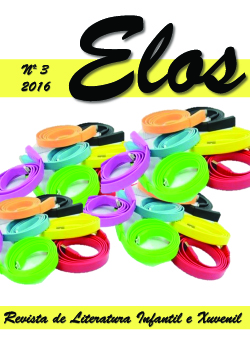A función descritivo-discursiva da verbovisualidade en libros ilustrados
Contido principal do artigo
Resumo
Como ben de interese cultural, o libro ilustrado presenta unha complexa conformación e require a observación de estratexias de lectura que auxilien o mediador no seu labor de captación do lector e de desenvolvemento da súa competencia interpretativa e fructifera. En contraste coa narratividade predominante no aspecto verbal do texto, o aspecto visual do libro ilustrado é considerado maioritariamente descriptivo e, así, participa dunha construción de sentidos baseada en inferencias e afectos, propicia para a avaliación dos seres e das cousas, pero tamén para a poeticidade. Este traballo pretende cuestionar o modo de significar do libro ilustrado, destacando mecanismos relacionados coa función descritivo-discursiva da verbovisualidade, co fin non só de comprender con maior profundidade o proceso significativo, senón tamén de contribuír á formación de mediadores da lectura conscientes das potencialidades dos textos. A base teórica do traballo está constituída por conceptos provenientes, sobre todo, da Teoría Semiolingüística da Análise do Discurso (Charaudeau, 2008; 2013), ademais de aspectos máis específicos do libro ilustrado (Nicolajeva e Scott, 2011; Linden, 2011). Para comprobar a efectividade desa función descriptivo-discursiva, elixíronse para a súa análise, obras ilustradas por Graça Lima, Odilon Moraes, Nelson Cruz, Marilda Castanha e Ellen Pestilli, entre outros.
Palabras chave
Detalles do artigo
Citas
BARTHES, Roland (1990). O óbvio e o obtuso. Rio de Janeiro: Nova Fronteira.
CHARAUDEAU, Patrick (1992). Grammaire du senset de l’expression. Paris: Hachette.
CHARAUDEAU, Patrick (2007). “Uma análise semiolinguística do texto e do discurso”. In: PAULIUKONIS; Maria Aparecida Lino; ; GAVAZZI, Sigrid (orgs.). Da língua ao discurso: reflexões para o ensino. (pp. 11-29). Rio de Janeiro: Lucerna.
CHARAUDEAU, Patrick (2008). Linguagem e discurso. São Paulo: Contexto.
CHARAUDEAU, Patrick (2013). “Imagem, mídia e política: construção, efeitos de sentido, dramatização, ética”. In: MENDES, Emília; MACHADO, Ida Lúcia; LIMA, Helcira; LYSARDO-DIAS, Dylia (orgs.). Imagem e discurso. (pp. 383-405). Belo Horizonte: Fale/UFMF.
COUTO, Mia (2008). O gato e o escuro. São Paulo: Companhia das Letrinhas. Ilustrações de Marilda Castanha.
CRUZ, Nelson (2012). A máquina do poeta. São Paulo: Comboio de corda.
FRANCE, Marycarolyn (2006). Cinderela brasileira. São Paulo: Paulus. Ilustrações de Graça Lima.
GIROUX, Henry Armand (1997). Os professores como intelectuais. Porto Alegre: Artmed Editora.
GOMES, Lenice (2011). A menina que bordava bilhetes. 2.ed. São Paulo: Cortez. Ilustrações de Ellen Pestili.
HUNT, Peter (2010). Crítica, teoria e literatura infantil. São Paulo: Cosac Naify.
JAKOBSON, Roman (1974). Linguística e comunicação. 2.ed. São Paulo: Cultrix.
KRESS, Gunther & LEEUWEN, Theo van (2006). Reading images: the grammar of visual design. 2.ed. Londres/Nova York: Routledge.
LIMA, Graça (2013). O ilustrador deve ser, antes de tudo, um leitor. 22 jun 2015, http://www.fundacaobunge.org.br
LINDEN, Sophie Van der (2011). Para ler o livro ilustrado. São Paulo: Cosac Naify.
LUCINDA, Elisa (2011). A dona da festa. Rio de Janeiro: Galerinha Record. Col. Amigo Oculto. Ilustrações de Graça Lima.
LUCINDA, Elisa (2011b). Lili, a rainha das escolhas. Rio de Janeiro: Galerinha Record.Col. Amigo Oculto. Ilustrações de Graça Lima.
LUCINDA, Elisa (2010). A menina transparente. Rio de Janeiro: Galerinha Record.Col. Amigo Oculto. Ilustrações de Graça Lima.
MONDADA, Lorenza & DUBOIS, Danièle (2003). “Construção dos objetos de discurso e categorização: uma abordagem dos processos de referenciação” (pp. 17-52) In: CAVALCANTE, Mônica Magalhães; RODRIGUES, Bernadete Biasi; CIULIA, AAlena (org.). Referenciação. São Paulo: Contexto.
NICOLAJEVA, Maria & SCOTT, Carole (2011). Livro ilustrado: palavras e imagens. São Paulo: Cosac Naify.
PEIRCE, Charles Sanders (2003). Semiótica. 3.ed. São Paulo: Perspectiva.
PIROLI, Wander (2014). O matador. São Paulo: Cosac Naify. Ilustrações de Odilon Moraes.
RIBEIRO, Marcelo (2008). “A relação entre o texto e a imagem”. In: OLIVEIRA, Ieda (org.). O que é qualidade em ilustração no livro infantil e juvenil: com a palavra o ilustrador. (pp. 123-139). São Paulo: DCL.
SANTAELLA, Lucia (2005). Matrizes da linguagem e pensamento: sonora, visual, verbal. 3.ed. São Paulo: Iluminuras: FAPESP.
SANTAELLA, Lucia (2012). Leitura de imagens. São Paulo: Melhoramentos.
SANTAELLA, Lucia & NÖTH, Winfried (2005). Imagem: cognição, semiótica, mídia. 4.ed. São Paulo: Iluminuras.
TAVIN, Kevin Michael; ANDERSON, David (2010). “A cultura visual nas aulas de arte do ensino fundamental: uma desconstrução da Disney”. In: MARTINS, Raimundo & TOURINHO, Irene (orgs.). Cultural visual e infância: quando as imagens invadem a escola. Santa Maria. (pp. 57-69). Santa Maria, Rio Grande do Sul: Editora da UFSM.
ZIRALDO Alves Pinto (1983). O menino mais bonito do mundo. 13.ed. São Paulo: melhoramentos. Ilustrações de Sami Mattar e Apoena Horta G. Medina.






